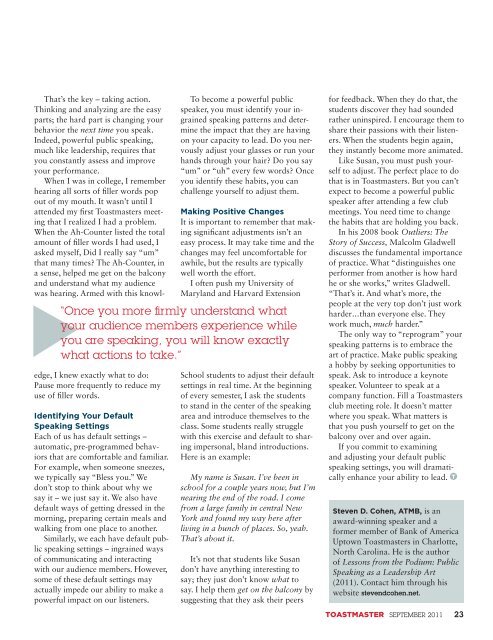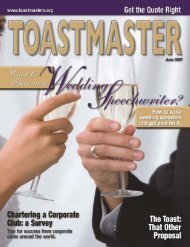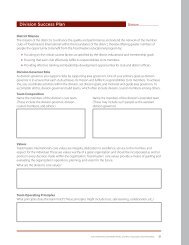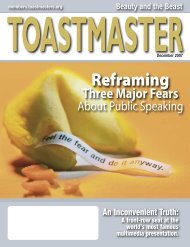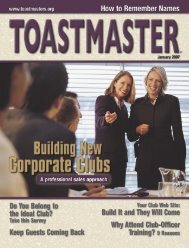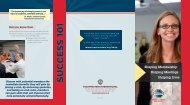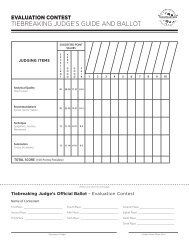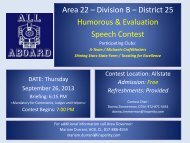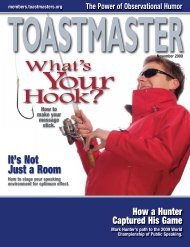September 2011 - District 25 Toastmasters
September 2011 - District 25 Toastmasters
September 2011 - District 25 Toastmasters
You also want an ePaper? Increase the reach of your titles
YUMPU automatically turns print PDFs into web optimized ePapers that Google loves.
That’s the key – taking action.<br />
Thinking and analyzing are the easy<br />
parts; the hard part is changing your<br />
behavior the next time you speak.<br />
Indeed, powerful public speaking,<br />
much like leadership, requires that<br />
you constantly assess and improve<br />
your performance.<br />
When I was in college, I remember<br />
hearing all sorts of filler words pop<br />
out of my mouth. It wasn’t until I<br />
attended my first <strong>Toastmasters</strong> meeting<br />
that I realized I had a problem.<br />
When the Ah-Counter listed the total<br />
amount of filler words I had used, I<br />
asked myself, Did I really say “um”<br />
that many times The Ah-Counter, in<br />
a sense, helped me get on the balcony<br />
and understand what my audience<br />
was hearing. Armed with this knowledge,<br />
I knew exactly what to do:<br />
Pause more frequently to reduce my<br />
use of filler words.<br />
Identifying Your Default<br />
Speaking Settings<br />
Each of us has default settings –<br />
automatic, pre-programmed behaviors<br />
that are comfortable and familiar.<br />
For example, when someone sneezes,<br />
we typically say “Bless you.” We<br />
don’t stop to think about why we<br />
say it – we just say it. We also have<br />
default ways of getting dressed in the<br />
morning, preparing certain meals and<br />
walking from one place to another.<br />
Similarly, we each have default public<br />
speaking settings – ingrained ways<br />
of communicating and interacting<br />
with our audience members. However,<br />
some of these default settings may<br />
actually impede our ability to make a<br />
powerful impact on our listeners.<br />
To become a powerful public<br />
speaker, you must identify your ingrained<br />
speaking patterns and determine<br />
the impact that they are having<br />
on your capacity to lead. Do you nervously<br />
adjust your glasses or run your<br />
hands through your hair Do you say<br />
“um” or “uh” every few words Once<br />
you identify these habits, you can<br />
challenge yourself to adjust them.<br />
Making Positive Changes<br />
It is important to remember that making<br />
significant adjustments isn’t an<br />
easy process. It may take time and the<br />
changes may feel uncomfortable for<br />
awhile, but the results are typically<br />
well worth the effort.<br />
I often push my University of<br />
Maryland and Harvard Extension<br />
“Once you more firmly understand what<br />
your audience members experience while<br />
you are speaking, you will know exactly<br />
what actions to take.”<br />
School students to adjust their default<br />
settings in real time. At the beginning<br />
of every semester, I ask the students<br />
to stand in the center of the speaking<br />
area and introduce themselves to the<br />
class. Some students really struggle<br />
with this exercise and default to sharing<br />
impersonal, bland introductions.<br />
Here is an example:<br />
My name is Susan. I’ve been in<br />
school for a couple years now, but I’m<br />
nearing the end of the road. I come<br />
from a large family in central New<br />
York and found my way here after<br />
living in a bunch of places. So, yeah.<br />
That’s about it.<br />
It’s not that students like Susan<br />
don’t have anything interesting to<br />
say; they just don’t know what to<br />
say. I help them get on the balcony by<br />
suggesting that they ask their peers<br />
for feedback. When they do that, the<br />
students discover they had sounded<br />
rather uninspired. I encourage them to<br />
share their passions with their listeners.<br />
When the students begin again,<br />
they instantly become more animated.<br />
Like Susan, you must push yourself<br />
to adjust. The perfect place to do<br />
that is in <strong>Toastmasters</strong>. But you can’t<br />
expect to become a powerful public<br />
speaker after attending a few club<br />
meetings. You need time to change<br />
the habits that are holding you back.<br />
In his 2008 book Outliers: The<br />
Story of Success, Malcolm Gladwell<br />
discusses the fundamental importance<br />
of practice. What “distinguishes one<br />
performer from another is how hard<br />
he or she works,” writes Gladwell.<br />
“That’s it. And what’s more, the<br />
people at the very top don’t just work<br />
harder...than everyone else. They<br />
work much, much harder.”<br />
The only way to “reprogram” your<br />
speaking patterns is to embrace the<br />
art of practice. Make public speaking<br />
a hobby by seeking opportunities to<br />
speak. Ask to introduce a keynote<br />
speaker. Volunteer to speak at a<br />
company function. Fill a <strong>Toastmasters</strong><br />
club meeting role. It doesn’t matter<br />
where you speak. What matters is<br />
that you push yourself to get on the<br />
balcony over and over again.<br />
If you commit to examining<br />
and adjusting your default public<br />
speaking settings, you will dramatically<br />
enhance your ability to lead. T<br />
Steven D. Cohen, ATMB, is an<br />
award-winning speaker and a<br />
former member of Bank of America<br />
Uptown <strong>Toastmasters</strong> in Charlotte,<br />
North Carolina. He is the author<br />
of Lessons from the Podium: Public<br />
Speaking as a Leadership Art<br />
(<strong>2011</strong>). Contact him through his<br />
website stevendcohen.net.<br />
TOASTMASTER SEPTEMBER <strong>2011</strong><br />
23


